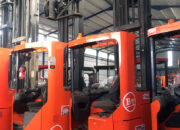Decoding the Hydraulic Kit of Container Reach Stackers — When Replacement Is Necessary
For any heavy-duty machine—especially container forklifts and reach stackers—the hydraulic system functions as the “muscles” and “blood vessels” of the entire equipment. It powers every critical operation: lifting tens of tons, extending the boom several meters, clamping, and adjusting the container spreader frame.
In the high-intensity environments of ports and container yards, even a minor issue—such as an oil leak—can immediately lead to complete downtime. Such downtime translates into massive indirect costs and supply chain disruptions.
Therefore, understanding the hydraulic kit—the core rebuilding solution—is the key to proactive maintenance and preventing catastrophic failures. This article by Samcovina addresses two crucial questions:
What exactly is a hydraulic kit?
And when is it mandatory to replace it?
What Exactly Is a “Hydraulic Kit”?
When people refer to a “hydraulic kit,” they often assume it’s a pump or cylinder assembly. In fact, the correct technical term is either a Seal Kit or Repair Kit.
It is not a complete hydraulic unit but a comprehensive set of seals, gaskets, O-rings, and other sealing components specifically designed to restore the function of a particular hydraulic component—such as a cylinder, pump, or control valve.
Common Types of Hydraulic Kits in Container Reach Stackers
In a heavy-duty reach stacker or container handler, the following kits are commonly found:
Cylinder Seal Kits: The most common type, used to re-seal various hydraulic cylinders:
Main Lift Cylinder Kit
Boom Extension Cylinder Kit
Spreader Tilt/Levelling Kit
Steering Cylinder Kit
Hydraulic Pump Seal Kit: Used when overhauling or rebuilding the main or control pumps.
Control Valve Seal Kit: Used to repair oil leaks or issues such as “load drift” and “uneven” control responses in the valve block.
Each kit—especially those from major manufacturers such as Kalmar, Konecranes, Linde, or Hyster—has a unique part number and highly precise specifications. Using the wrong kit, even with a minor mismatch, can result in repair failure.
Anatomy of a Standard Cylinder Seal Kit
So, what exactly is inside a typical hydraulic cylinder seal kit—the most common type?
A standard cylinder kit includes these critical components:
Piston Seals: The most important component, located on the piston head, preventing hydraulic oil from bypassing between the two cylinder chambers. A damaged piston seal causes pressure loss, resulting in load drop or cylinder drift.
Rod or Gland Seals: Positioned in the gland (guide cap), these seals prevent oil from leaking externally along the piston rod. They are the main cause of visible “teardrop” oil leaks.
Wear Rings / Guide Rings: Typically made from composite or phenolic material, they center the piston and rod, preventing metal-to-metal contact that could damage the cylinder barrel.
Wiper Seals / Dust Seals: Located at the outermost gland position, they act as the first line of defense—wiping away dust, moisture, and debris from the piston rod to protect the internal system.
O-Rings & Static Seals: Used to seal static joints, such as between the cylinder cap and barrel.
Samcovina’s Expert Note:
The seal material (PU, NBR, Viton, PTFE, etc.) is critical. Under extremely high pressure (typically over 250 bar) and harsh port environments (heat, dust, and salt), cheap, non-OEM kits deteriorate quickly—they can harden, crack, or wear out within a few hundred hours instead of thousands, leading to repeated failures and costly downtime.
When Should the Entire “Hydraulic Kit” Be Replaced?
Replacement may occur under two conditions: reactive (after failure) or proactive (scheduled maintenance).
- Warning Signs (Failure Symptoms)
If your machine exhibits any of the four classic symptoms below, the hydraulic kit has reached the end of its service life and must be replaced immediately:
External Oil Leakage
Symptoms: Visible oil dripping or continuous wetness around the cylinder gland or joints.
Cause: Worn, torn, or hardened rod or wiper seals.
Internal Leakage / Drift
Symptoms: The boom or spreader gradually drops even when controls are in the neutral “hold” position.
Cause: Damaged piston seal allowing internal oil bypass.
Slow or Weak Operation
Symptoms: Lifting or boom extension is slower, weaker, or fails to reach full capacity.
Cause: Internal cylinder leakage or worn hydraulic pump reducing system pressure.
Overheated Hydraulic Oil with Burning Smell
Symptoms: Abnormally high oil temperature, sometimes with a burnt odor.
Cause: Internal leakage in the pump, valve, or cylinder causing excessive friction and heat—eventually degrading the oil and damaging the entire system.
- Proactive (Scheduled) Maintenance
Never wait for a breakdown. Leading ports practice preventive replacement of hydraulic kits based on manufacturer-recommended operating hours (OEM schedule).
Example: A main lift or boom cylinder may require re-sealing every 10,000–15,000 operating hours, depending on model and working conditions (24/7 operation, dust, or marine environments).
Benefit: Scheduled replacement prevents sudden failures, minimizes safety risks (e.g., load drop accidents), and allows planned maintenance during low-activity periods.
Replace the “Kit” or the Entire “Assembly”?
This is a critical financial decision: when to purchase a seal kit only versus a complete cylinder or pump assembly.
Case 1: Replace the Kit Only (Re-Sealing)
This is the most cost-effective and commonly used approach for regular maintenance.
When: The cylinder shows normal wear and seal aging but no mechanical damage.
Condition: The piston rod and barrel surface must be in good condition—no deep scratches, corrosion, bending, or dents.
Solution: The repair center (like Samcovina) disassembles, cleans, inspects, installs new OEM-quality seals, and reassembles the component.
Case 2: Replace the Entire Assembly (New or Used Cylinder/Pump)
In some cases, re-sealing alone is pointless because damage is too severe. Full replacement is mandatory when:
The piston rod is bent or broken due to impact.
The rod or barrel has deep scratches (from dust ingress or failed wipers), which will instantly destroy new seals.
The cylinder body is cracked or dented from collision.
The hydraulic pump is worn, cracked, or has internal mechanical failure (e.g., damaged swash plate or pistons).
In such cases, Samcovina offers comprehensive solutions—from brand-new OEM components (imported from Europe, the U.S., Japan, or Korea) to certified used assemblies, helping customers optimize maintenance costs without compromising reliability.







